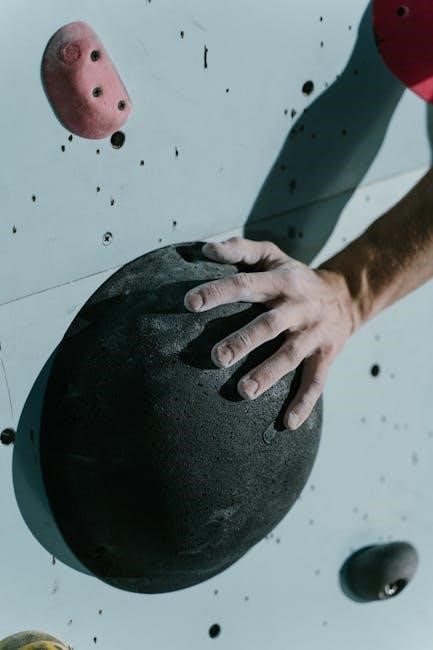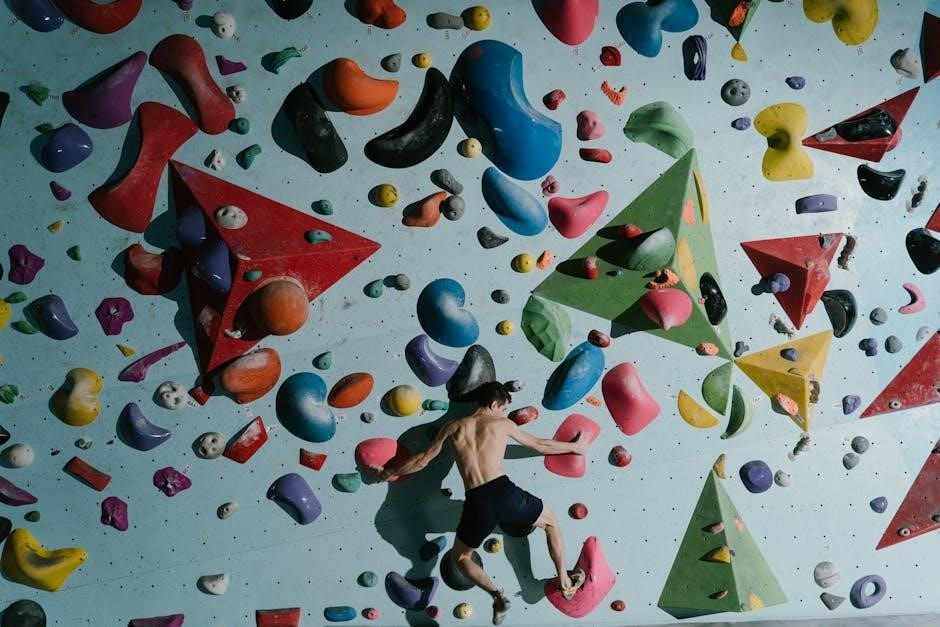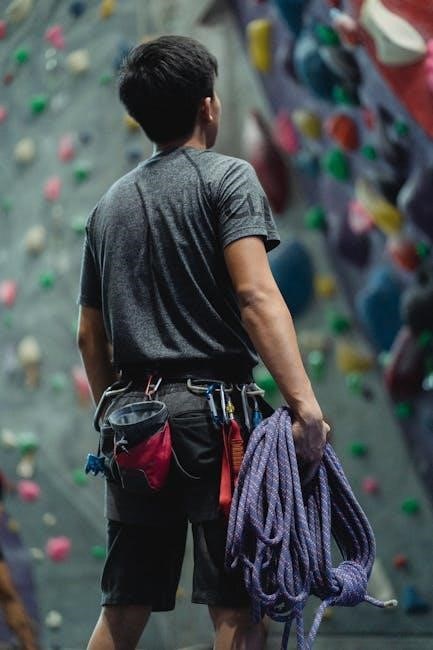The Rock Climbers Training Manual is a comprehensive guide designed to help climbers of all levels enhance their performance through tailored strategies for strength, technique, and mental resilience, ensuring a balanced and effective approach to reaching new heights in their climbing journey.
Overview of the Manual’s Purpose and Structure
The Rock Climbers Training Manual serves as a detailed guide for climbers aiming to enhance their skills and physical conditioning. Structured to cater to climbers of all levels, the manual emphasizes a balanced approach to training, incorporating strength, technique, and mental resilience. It is divided into clear sections, each addressing specific aspects of climbing improvement, such as strength training, mental strategies, and injury prevention. The manual provides practical advice, training plans, and real-world examples, ensuring climbers can tailor their approach to their goals and lifestyle. By focusing on sustainable progress and long-term development, it equips climbers with the tools to maximize their potential while staying motivated and injury-free.
Key Concepts for Beginners
For those new to rock climbing, the manual emphasizes foundational principles to build a strong base. It highlights the importance of understanding basic climbing techniques, such as footwork and body positioning, to maximize efficiency and reduce fatigue. Beginners are encouraged to focus on grip strength and open-hand techniques to minimize injury risks. The manual also stresses the value of setting realistic goals and tracking progress, creating a structured yet flexible training plan. Additionally, it introduces essential concepts like fingerboards, hangboards, and auxiliary exercises to gradually build strength and endurance. By mastering these basics, climbers can establish a solid foundation for more advanced techniques and enjoy a safer, more rewarding climbing experience from the start.

Strength Training for Rock Climbers
Strength training is crucial for climbers, focusing on maximizing grip strength, power, and endurance through targeted exercises like hangboard workouts and auxiliary training, ensuring a scientific approach to climbing physiology.
Maximizing Grip Strength and Power
Grip strength is foundational for climbers, defined as the force generated during initial contact with holds. The manual emphasizes hangboard workouts, auxiliary exercises, and skin care to enhance power. Open-hand hangs and varied grip techniques are recommended to build endurance and avoid injury. Consistency and progressive overload in training routines ensure steady improvement. Avoiding closed crimps reduces injury risk while maximizing efficiency. Regular skin maintenance, like sanding, promotes durability. These strategies collectively optimize grip performance, enabling climbers to tackle challenging routes with confidence and control, making grip strength a critical component of overall climbing success.
Hangboard Workouts and Auxiliary Exercises
Hangboard workouts are central to building finger strength, with routines tailored to target specific grip types. Auxiliary exercises like pull-ups and wrist curls complement hangboard training, enhancing overall upper body strength. The manual suggests varying hang durations and weights to avoid plateaus. Skin care is emphasized to prevent injuries, ensuring sustained progress. These workouts, combined with proper technique, form a robust strategy for climbers seeking to improve their grip power and endurance, ultimately elevating their performance on the wall.

Mental Strategies for Climbing Success
Mental preparation is crucial for climbers, emphasizing resilience, focus, and confidence. Techniques like positive self-talk and mindfulness help climbers stay composed under pressure, fostering peak performance and continuous improvement.
Goal Setting and Mental Preparation
Effective goal setting is essential for climbers to stay motivated and track progress. Start by defining clear, achievable objectives, whether improving technique or conquering a specific route. Mental preparation involves cultivating focus, confidence, and resilience. Techniques like mindfulness and visualization help climbers stay calm under pressure. Breaking goals into smaller steps ensures steady improvement and avoids overwhelming feelings. Prioritize self-awareness to understand strengths and areas for growth. Regular reflection on training and performance helps refine strategies. A well-structured mental approach not only enhances physical performance but also fosters a positive mindset, crucial for overcoming challenges and maintaining consistency in training. This balance of ambition and realism is key to long-term success in climbing.
Visualization Techniques for Route Mastery
Visualization is a powerful tool for climbers to mentally rehearse routes, enhancing route comprehension and performance. By vividly imagining each sequence of moves, climbers can better anticipate challenges and refine their strategy. Start by studying the route through photos, videos, or descriptions, then close your eyes and mentally map out hand and footholds. Focus on the sensations of movement, grip pressure, and body positioning. Regular visualization practice strengthens mental clarity and reduces fear of the unknown. This technique also helps build confidence and reduces hesitation during actual climbs. Consistent mental rehearsal can significantly improve efficiency and success on the rock, making it an invaluable skill for climbers of all levels.
Building Resilience and Overcoming Fear
Building resilience and overcoming fear are essential for climbers to progress and stay motivated. Fear of falling or failure can be debilitating, but it can be managed through gradual exposure to challenging situations. Start by identifying the source of fear and breaking it down into manageable parts. Practice controlled exposure to risky scenarios in a safe environment, such as falling on a top-rope setup, to build trust in equipment and techniques. Breathing exercises and positive self-talk can help calm nerves and refocus the mind. Over time, climbers develop resilience by embracing failures as learning opportunities rather than setbacks. This mindset shift fosters confidence and determination, allowing climbers to push past mental barriers and achieve their goals.
Physical Conditioning and Injury Prevention
Physical conditioning and injury prevention are crucial for climbers to maintain peak performance and longevity. Regular skin care, such as sanding, promotes durability and reduces tears. Avoiding full-crimp holds minimizes finger injuries, while strength and flexibility routines enhance overall resilience, ensuring climbers stay healthy and perform at their best.
Flexibility and Mobility Routines
Flexibility and mobility are essential for climbers to maintain optimal range of motion and prevent stiffness. Incorporating dynamic stretches before climbs and static stretches after can enhance joint mobility. Yoga and active isolated stretching target key areas like shoulders, hips, and hamstrings. Regularly practicing these routines improves overall flexibility, allowing climbers to move more efficiently and maintain proper technique. Consistency is key to long-term mobility and injury prevention. By dedicating time to these exercises, climbers can ensure their bodies remain adaptable and resilient, supporting their climbing performance and overall well-being. These practices not only enhance physical capabilities but also contribute to a sustainable and injury-free climbing career.
Core Strength and Stability Exercises
Core strength is vital for climbers, as it provides the stability and control needed to maintain balance on the wall. Exercises like planks, hollow body holds, and leg raises target the abdominal muscles, obliques, and lower back. These movements improve posture and reduce fatigue during climbs. Anti-rotational exercises, such as the Pallof press, enhance rotational stability, crucial for maintaining body positioning. Incorporating these routines into your training regimen strengthens the core, boosts overall climbing performance, and helps prevent injuries. Consistent practice ensures a solid foundation, allowing climbers to focus on technique and endurance with greater confidence and precision.

Time Management for Busy Climbers
Time management is crucial for climbers balancing work and life. Prioritize training sessions, focus on efficiency, and integrate exercises into daily routines to avoid burnout and optimize performance.
Balancing Work, Life, and Training
Managing a demanding schedule while maintaining a consistent training regimen is a common challenge for climbers. Prioritizing time and setting realistic goals are essential to avoid burnout. Many climbers work full-time jobs, making it crucial to integrate training into daily routines without compromising work or personal life. Strategies include time-blocking, focusing on high-intensity workouts, and leveraging small time slots for mobility or core exercises. Rest and recovery should also be scheduled to prevent overtraining and injury. By creating a structured yet flexible plan, climbers can sustain their progress while maintaining overall well-being. This approach ensures that training complements life rather than overwhelming it, fostering long-term consistency and enjoyment of the sport.
Creating an Effective Training Schedule
Developing a structured training schedule is vital for consistent progress in climbing. Start by assessing your goals, available time, and current fitness level. Allocate specific days for strength, technique, and endurance workouts, ensuring a balance between climbing and auxiliary exercises. Periodization is key—break your training into cycles, focusing on different aspects like power, endurance, or technique over set periods. Incorporate rest days to allow for recovery and adaptation. Use time-blocking to dedicate specific hours to training, avoiding overcommitment. Prioritize quality over quantity, focusing on high-impact activities that yield results. Adjust the schedule as needed to maintain motivation and avoid plateaus. A well-organized plan ensures efficiency, helping climbers make the most of their limited time while advancing their skills effectively.

Community and Resources
The Rock Climbers Training Manual emphasizes building a supportive network through online forums, local climbing groups, and shared resources, fostering growth and camaraderie among climbers worldwide.
Building a Supportive Climbing Network
Building a supportive climbing network is crucial for long-term success and motivation. Joining local climbing groups or online forums connects you with experienced climbers who can offer advice and encouragement. Attending community events or workshops fosters camaraderie and provides opportunities to learn new techniques. Sharing experiences and challenges with fellow climbers creates a sense of belonging and accountability. Additionally, platforms like RCTM.com allow climbers to ask questions, share insights, and expand their knowledge base. A strong network not only enhances your climbing journey but also helps you stay inspired and motivated, ensuring you continue to grow and improve as a climber.
Online Forums and Training Guides
Online forums and training guides are invaluable resources for climbers seeking knowledge and community support. Platforms like RCTM.com offer spaces to ask questions, share experiences, and gain insights from experienced climbers. These forums often feature detailed training plans, video tutorials, and expert advice tailored to different skill levels. Additionally, many websites provide comprehensive guides on topics such as strength training, mental strategies, and injury prevention. Engaging with these resources allows climbers to refine their techniques, stay updated on best practices, and connect with a global climbing community. By leveraging online tools, climbers can enhance their training effectiveness and build a stronger foundation for their climbing pursuits.